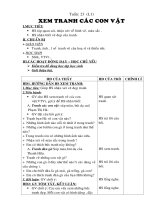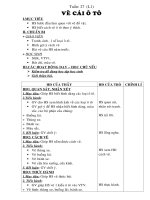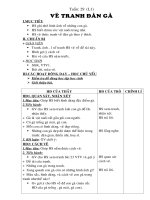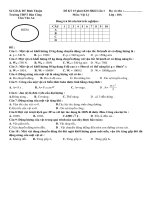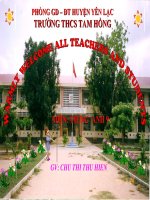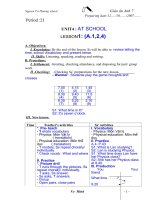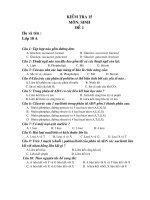Cre l1 introduciton
Bạn đang xem bản rút gọn của tài liệu. Xem và tải ngay bản đầy đủ của tài liệu tại đây (151.05 KB, 13 trang )
605037: Chemical Reaction Engineering
(Homogeneous Reactions in Ideal Reactors)
Course Information (Semester 1, 2013)
Lecturer: Dr. Le Thi Kim Phung
Room: Vice Dean Office, Faculty of Chemical
Engineering.
Tel: 0938009307
Email:
Lectures:
Fridays: 6:30-9:00
Textbook
Octave Levenspiel,
“Chemical Reaction
Engineering”,
John Wiley&Sons,
3rd edition, 1999
E-learning
Material relating to the subject can be accessed
through e-learning.
The web site contains material including online
quizzes, tutorial sheets, and additional lecture
material including powerpoint presentations.
Announcements will also be made through the
web site.
REFERENCE BOOKS
1. H. Scot Foggler, “Elements of Chemical
Reaction Engineering”, International students
edition, 1989.
2. E.B.Nauman, “Chemical Reactor Design”, John
Wiley & sons, 1987.
3. Stanley M. Walas, “Reaction Kinetics for
Chemical Engineers”,Int. Student Edition, 1990.
4. Coulson & Richardsons, “Chemical
Engineering – Vol 6”, Elsevier, 1979.
5. Richard M. Felder, “Elementary Principles of
Chemical Processes”, John Wiley & sons, 2000.
Assessment
Final Examination (2 Hr Closed Book)
Intra-Semester Assessment
TOTAL
The Intra-Semester Assessment is
breakdown as follow
3-4 assignment s
1 seminar
1 mid-semester Test
60 %
40 %
100 %
10%
10%
20%
Aims of the course
The Chemical Reaction Engineering provides
the knowledge and calculation skills of the
homogeneous reactors based on two models:
mixing and plug flow.
Base on the knowledge gained from this subject,
students can do the experiments (resident time
population), process and equipment design
project and student apprentice.
Outcomes
At the end of the course you should be able to:
ă Student can interpret the chemical kinetics data.
ă Student can calculate and optimal design
chemical reactors apply for every reaction.
Contents
Chapter 1 : Overview of Chemical Reaction
Engineering
Chapter 2 : Kinetics of Homogeneous Reactions
Chapter 3 : Interpretation of Batch Reactor Data
Chapter 4 : Introduction to Reactor Design
Chapter 5 :Ideal Reactors for a Single Reaction
04/28/2023
8
Contents
Chapter 6 : Design for Single Reactions
Chapter 7 :Design for Parallel Reactions
Chapter 8: Potpourri of Multiple Reactions
Chapter 9: Temperature and Pressure Effects
Chapter 10: Choosing the Right Kind of Reactor
04/28/2023
9
Emails
In addition to the E - learning web site, e-mail will be used to
advise the class of new notices and updates of course
information and materials. Please check your university e-mail
accounts regularly.
You are welcome to use e-mail to communicate with me if you
have a straightforward question that requires only a short
answer on my part and I will respond as soon as practicable.
However, please do not use e-mail for questions that are likely
to require a long and complicated answer. Such questions are
better dealt with in a face-to-face meeting, which will also
provide better learning outcomes. If you do communicate with
me or any other member of staff by e-mail, please remember
that it is a formal, archival document similar to a formal letter,
not an SMS text message.
E-mails sent to me that do not have a formal
opening and closing will be ignored.
Mobile Phones
As a simple courtesy to others all
mobile phones MUST be turned off
before entering the lecture theatre
and tutorial class.
Study Commitments
In order to pass this subject to the best of
your abilities you must attend all lectures,
complete all tutorial sheets and spend on
average 6 to 8 hours per week in private
study. This time would be spent in
reviewing lectures, doing the tutorial
sheets and additional problems and
studying for the exam. The 6 to 8 hours
per week should commence in the first
week of semester.
What I hear, I forget;
What I see, I remember;
What I do, I understand.
Confucius

